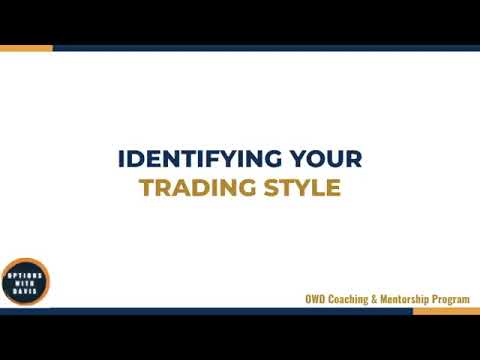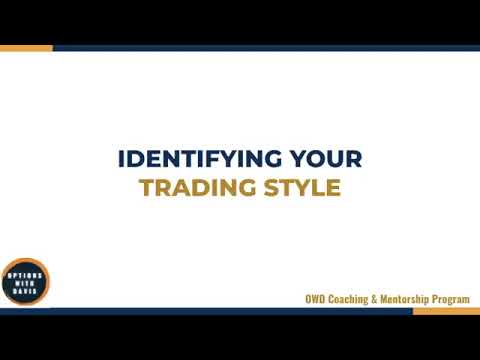In this video titled “4-1 Identifying Your Trading Style,” we will discuss the various trading methods and risk strategies that you can choose from. The video will guide you in determining your trading style by asking yourself a few important questions. You will have the option to trade both the unlimited income trading method and the put ratio spread, or choose just one of them based on your capital and preferences. Additionally, you will need to decide whether you want to trade defined risk strategies, undefined risk strategies, or a mix of both. The video will also cover the choice between trading index ETFs or a combination of ETFs and individual stocks. Furthermore, it will explore the option of trading all levels or focusing on specific levels when using the unlimited income trading method. By the end of the video, you will be encouraged to find your own trading style that aligns with your comfort level and market outlook.
Identifying Your Trading Style
In order to determine your trading style, you need to consider a few key factors and make some decisions about the trading methods, strategies, and assets you prefer to trade.
Determining the trading methods you prefer
First, you need to understand the two main trading methods: the unlimited income trading method and the put ratio spread method. The unlimited income trading method involves generating income from options trades, while the put ratio spread method focuses on managing risk by trading put options.
Take some time to familiarize yourself with both methods and consider which one aligns better with your goals and trading preferences. This will help you narrow down your trading style and focus on the method that suits you best.
Deciding between unlimited income trading and put ratio spread
Once you have a good understanding of both trading methods, it’s time to make a decision. Will you trade both the unlimited income trading method and the put ratio spread method, or will you choose to focus on just one of them?
This decision may depend on the amount of capital you have available. If you have a larger capital, you may choose to trade both methods. However, if your funds are limited, you may prefer to specialize in one method that you feel more comfortable with.
Consider the potential returns and risks associated with each method and choose the one that aligns with your risk appetite and trading goals.

Choosing between defined risk and undefined risk strategies
Another important consideration is whether you will trade defined risk strategies, undefined risk strategies, or a mix of both. Defined risk strategies involve limiting potential losses by using options contracts with a predetermined risk level. On the other hand, undefined risk strategies have unlimited potential risk.
Evaluate your capital and assess the potential returns and risks of each strategy. If you have a smaller capital, it may be more suitable to stick with defined risk strategies. However, if you have a larger capital, you can consider undefined risk strategies or a combination of both.
Ultimately, choose the strategy that aligns with your risk tolerance and trading goals.
Considering a mix of both risk strategies
Combining defined risk and undefined risk strategies can offer certain advantages. It allows you to diversify your trading approach and potentially maximize your returns. However, it’s important to assess the benefits and drawbacks of this mixed strategy.
Determine the appropriate allocation of capital for each strategy and develop a plan to manage the risks and rewards of this combined approach. This will help you navigate the market effectively and make well-informed trading decisions.
Assessing the capital you have available
The amount of capital you have available will greatly influence your trading options. Consider how your capital can be allocated to different trading methods and strategies.
Evaluate the amount of capital you have and determine which trading methods and strategies are suitable for your available capital. By doing so, you can ensure that you have enough resources to execute your trades effectively.
Deciding whether to trade index ETFs, stocks, or a mixture of both
Another decision you’ll need to make is whether you want to trade index ETFs, stocks, or a combination of both. Each option has its advantages and disadvantages.
Index ETFs provide diversification and the ability to trade a basket of securities, while individual stocks offer the potential for higher returns but also higher risks.
Consider the current market conditions and trends and decide on the appropriate mix of index ETFs and stocks for your trading style. This will help you create a well-rounded portfolio and optimize your trading opportunities.
Deciding which levels of the unlimited income trading method to trade
If you choose to trade the unlimited income trading method, you’ll need to decide which levels to trade. The method involves different levels, ranging from one to six.
Understand the different levels and explore the potential opportunities and risks associated with each level. Depending on your risk tolerance and trading preferences, you may choose to trade all levels or focus on specific levels. This decision should be based on your analysis of price extremes and their impact on trading.
Understanding price extremes and their impact on trading
Price extremes play a crucial role in trading decisions. It is important to define what constitutes a price extreme and consider the benefits and drawbacks of trading at these levels.
Explore the trading opportunities and risks associated with price extremes. Decide whether you want to focus on trading only at price extremes or if you want to incorporate them into your overall trading strategy.
Identifying strategies with no risk to the upside
For traders concerned about the upside risk, it’s worth exploring strategies that have no risk to the upside. Options strategies like the Jade lizard, put ratio spread, put broken wing butterfly, and skillfully structured iron condors offer limited or no risk to the upside.
Consider these strategies if you have a bullish outlook in the long term and want to minimize your potential losses to the upside. Find the strategy that suits your preferences and risk tolerance.
In conclusion, identifying your trading style involves considering various factors such as trading methods, risk strategies, available capital, asset preference, and the impact of price extremes. Take the time to understand each component and make informed decisions that align with your goals and preferences. Remember, your trading style should be a reflection of your unique trading objectives and risk tolerance.
